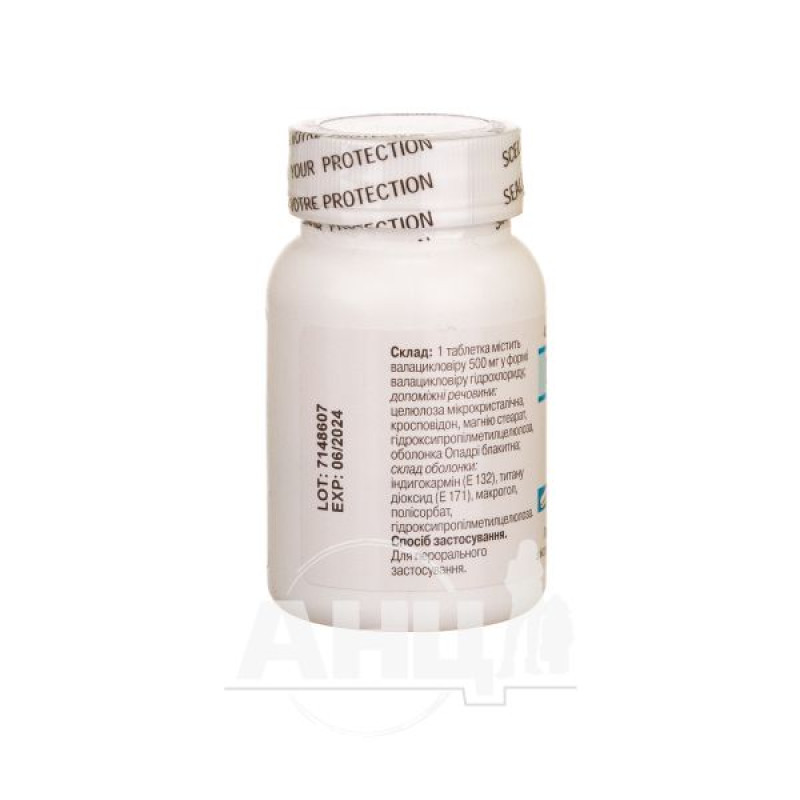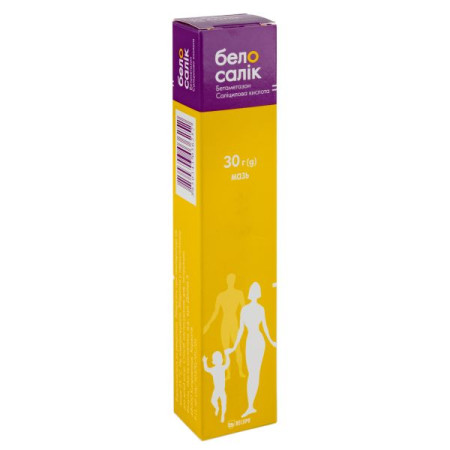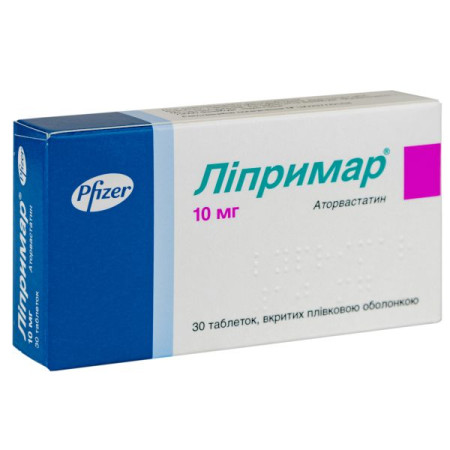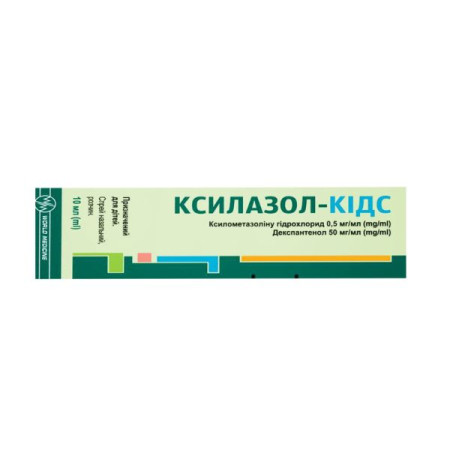Valcyk film-coated tablets 500 mg bottle No. 42
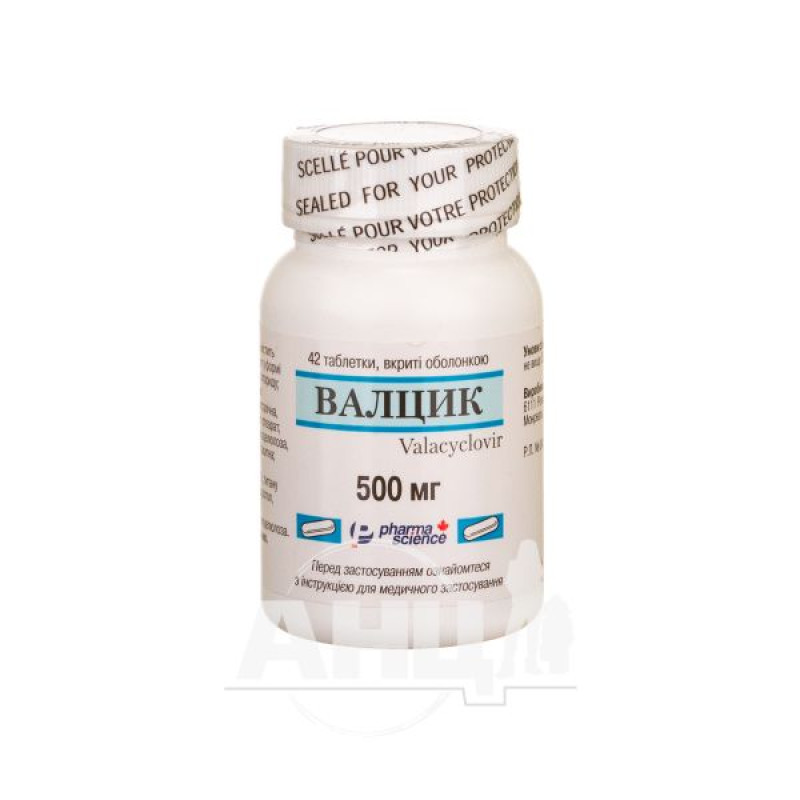
Instructions for Valcyk film-coated tablets 500 mg bottle No. 42
Composition
active ingredient: valacyclovir;
1 tablet contains valacyclovir 500 mg in the form of valacyclovir hydrochloride;
excipients: microcrystalline cellulose, crospovidone, magnesium stearate, hydroxypropylmethylcellulose, Opadry blue coating;
shell composition: indigo carmine (E 132), titanium dioxide (E 171), macrogol, polysorbate, hydroxypropyl methylcellulose.
Dosage form
Film-coated tablets.
Main physicochemical properties: blue oblong, film-coated tablets, imprinted with “VC” and “500” on one side, smooth or smooth on both sides on the other side.
Pharmacotherapeutic group
Direct-acting antiviral drugs. ATX code J05A B11.
Pharmacological properties
Pharmacodynamics
Valacyclovir is an antiviral drug, the L-valine ester of acyclovir, which is an analogue of the purine nucleoside guanine. In the human body, valacyclovir is rapidly and almost completely converted to acyclovir and valine by valacyclovir hydrolase. Acyclovir is a specific inhibitor of herpes viruses with in vitro activity against herpes simplex viruses types I and II, Varicella zoster virus, cytomegalovirus, Epstein-Barr virus, and human herpes virus type VI. Acyclovir inhibits viral DNA synthesis immediately after phosphorylation and conversion to the active form acyclovir triphosphate. The first stage of phosphorylation requires the activity of a virus-specific enzyme.
For herpes simplex virus, Varicella zoster virus, and Epstein–Barr virus, this is the viral thymidine kinase (TK), which is present only in virus-infected cells. Partial selectivity of phosphorylation is preserved in cytomegalovirus infection and is mediated through the UL 97 phosphatase gene product. Activation of acyclovir by a specific viral enzyme largely explains its selectivity.
The process of phosphorylation of acyclovir (conversion from mono- to triphosphate) is carried out by cellular kinases. Acyclovir triphosphate competitively inhibits viral DNA polymerase and is incorporated into viral DNA, which leads to obligate (complete) chain termination, cessation of DNA synthesis and, consequently, to blocking viral replication.
Resistance to acyclovir is due to a deficiency of the viral thymidine kinase, which leads to excessive spread of the virus in the body. Sometimes reduced sensitivity to acyclovir is due to the emergence of virus strains with a disrupted structure of the viral TC or DNA polymerase. The virulence of these variants of the virus resembles that of its wild-type strain.
Extensive monitoring of clinical isolates of herpes simplex virus and Varicella zoster virus in patients treated with acyclovir has made it possible to find out that in patients with normal immunity, a virus with reduced sensitivity to acyclovir is extremely rare and infrequently manifests itself only in patients with severe immune disorders, for example, after organ transplantation or in bone marrow recipients, during chemotherapy for malignant neoplasms and HIV-infected patients.
Valacyclovir accelerates the cessation of pain in the treatment of herpes zoster, reduces the duration of pain syndrome, as well as the number of patients with zoster-associated pain, including acute and postherpetic neuralgia.
Prophylaxis of cytomegalovirus infection with valacyclovir reduces the risk of acute transplant rejection (in kidney transplant patients), the incidence of opportunistic infections, and other infections caused by the herpes virus (herpes simplex virus and herpes zoster virus).
Pharmacokinetics
Absorption. After oral administration, valaciclovir is well absorbed, rapidly and almost completely converted to acyclovir and valine. This conversion, apparently, occurs with the help of the enzyme valaciclovir hydrolase, isolated from the human liver. The bioavailability of acyclovir when taking 1 g of valaciclovir is 54% and is not reduced by food intake. The pharmacokinetics of valaciclovir are not dose-dependent. The rate and extent of absorption decrease with increasing dose, leading to a less proportional increase in Cmax within the therapeutic dose range and a decrease in bioavailability when using doses greater than 500 mg. The average peak concentration of acyclovir is 10-37 μmol (2.2-8.3 μg / ml) after a single dose of 250-2000 mg of valaciclovir to healthy volunteers with normal renal function, and the median time to reach this concentration is 1-2 hours. Peak plasma concentrations of valacyclovir are only 4% of those of acyclovir, occurring on average within 30-100 minutes and declining below measurable levels after 3 hours. The pharmacokinetics of valacyclovir and acyclovir are similar after single and repeated administration.
Distribution: The binding of valaciclovir to plasma proteins is very low - 15%. Penetration into cerebrospinal fluid (CSF), as determined by the ratio of CSF/plasma AUC, is approximately 25% for acyclovir and the metabolite 8-hydroxyacyclovir and 2.5% for the metabolite 9-carboxymethoxymethylguanine.
After oral administration, valaciclovir is converted to acyclovir and L-valine by first-pass metabolism in the intestine and/or liver. Acyclovir is converted to a small extent to the metabolites 9-carboxymethoxymethylguanine by alcohol and aldehyde dehydrogenase and to 8-hydroxyacyclovir by aldehyde oxidase. Approximately 88% of the total plasma exposure is attributable to acyclovir, 11% to 9-carboxymethoxymethylguanine, and 1% to 8-hydroxyacyclovir. Neither valaciclovir nor acyclovir are metabolized by cytochrome P450 enzymes.
Elimination: The half-life of acyclovir after single and multiple doses of valaciclovir in patients with normal renal function is approximately 3 hours. Valaciclovir is excreted in the urine, mainly as acyclovir (more than 80% of the dose) and its metabolite 9-carboxymethoxymethylguanine.
Special patient groups.
In patients with end-stage renal failure, the half-life of acyclovir is approximately 14 hours.
Herpes zoster virus and herpes simplex virus do not significantly alter the pharmacokinetics of acyclovir and valacyclovir after oral administration of Valcyte.
In a study of the pharmacokinetics of valaciclovir and acyclovir during late pregnancy, the area under the acyclovir concentration-time curve in the plateau phase after administration of valaciclovir at a dose of 1000 mg was approximately 2 times higher than after administration of acyclovir orally at a dose of 1200 mg per day.
In patients with HIV infection, the pharmacokinetic characteristics of acyclovir after single or multiple doses of 1000 mg or 2000 mg of valaciclovir did not change compared to those in healthy subjects.
In organ transplant recipients receiving valaciclovir 2000 mg 4 times daily, peak acyclovir concentrations were equal to or greater than those in healthy volunteers receiving the same dose, and daily AUCs were significantly greater.
Indication
Treatment of herpes zoster.
Treatment of infections of the skin and mucous membranes caused by the herpes simplex virus, including primary and recurrent genital herpes.
Treatment of labial herpes (cold sores).
Preventive treatment (suppression) of recurrences of skin and mucous membrane infections caused by the herpes simplex virus, including genital herpes.
Reducing the transmission of genital herpes virus to a healthy partner when using Valcyte as suppressive therapy in combination with safe sex.
Prevention of cytomegalovirus infection and disease after organ transplantation.
Contraindication
Hypersensitivity to valacyclovir, acyclovir or any component of the drug.
Interaction with other medicinal products and other types of interactions
No clinically significant forms of interaction were identified.
It is not recommended to adjust the dose of valacyclovir when prescribed with digoxin, antacids, thiazide diuretics, cimetidine, or probenecid in patients with normal renal function.
Acyclovir is excreted mainly unchanged in the urine by active tubular secretion. Any drugs that are prescribed simultaneously and that affect this mechanism of excretion may increase the concentration of acyclovir in the blood plasma after the use of valacyclovir. When taking cimetidine or probenecid, which block tubular secretion, after taking valacyclovir at a dose of 1 g, the area under the "concentration-time" curve of acyclovir increases and its renal clearance decreases, but there is no need to change the dose given the wide therapeutic index of acyclovir.
For patients receiving higher doses of valaciclovir (4 g or more per day), caution should be exercised when co-administering drugs that compete with acyclovir for elimination pathways, as this may lead to increased plasma levels of one or both drugs and their metabolites. Co-administration with mycophenolate mofetil (an immunosuppressive drug used after organ transplantation) has been associated with increased plasma levels of acyclovir and the inactive metabolite of mycophenolate mofetil.
Caution should also be exercised (with monitoring of changes in renal function) when co-administering high doses of valacyclovir (4 g or more) and other drugs that affect renal function (e.g. cyclosporine, tacrolimus).
Application features
Hydration.
Adequate fluid intake should be maintained in patients at increased risk of dehydration, especially in elderly patients.
Liver dysfunction.
There are no data on the use of higher doses of the drug (4 mg or more per day) in the treatment of patients with liver disease. Therefore, caution should be exercised when prescribing higher doses to such patients. Specific studies on the use of valacyclovir in liver transplantation have not been conducted, but it has been found that prophylaxis with high doses of acyclovir reduces the incidence of infection and disease caused by cytomegalovirus.
Kidney dysfunction.
Acyclovir, the active metabolite of valacyclovir, is excreted by the kidneys, so the dose of valacyclovir for patients with renal insufficiency should be reduced, taking into account creatinine clearance.
Patients with renal insufficiency are at increased risk of developing neurological complications and, in order to detect them in time, should be closely monitored. As a rule, these complications are reversible and disappear after discontinuation of the drug. Caution should be exercised when prescribing valaciclovir to patients with renal insufficiency or to patients taking nephrotoxic drugs, as this may increase the risk of developing impaired renal function and/or the risk of reversible adverse reactions from the nervous system.
When treating herpes labialis with valacyclovir, special attention should be paid to elderly patients and patients with renal insufficiency. Treatment should not exceed 1 day (2 doses of 2000 mg within 24 hours). Therapy for more than 1 day will not have an additional clinical effect.
Elderly patients.
Elderly patients have reduced renal function and require dose adjustment.
For elderly patients, dosage should be based on creatinine clearance and adequate hydration should be maintained.
Patients with renal impairment and the elderly are at increased risk of developing neurological complications and require close monitoring for these effects. These reactions have been reported to be reversible in most cases after discontinuation of treatment (see section 4.8).
Reducing transmission of genital herpes virus
Suppressive therapy with valacyclovir reduces the risk of transmission of genital herpes. It does not cure herpes infection, nor does it completely eliminate the risk of transmission of the virus. In addition to valacyclovir therapy, patients are advised to use barrier contraception.
Use in the treatment of herpes zoster
When treating patients, especially those who are immunocompromised, clinical response should be closely monitored. If the response to treatment is inadequate, intravenous antiviral therapy is recommended. Patients with complicated herpes zoster, such as those with visceral involvement, viral dissemination, motor neuropathy, encephalitis, and cerebrovascular disorders, should be treated with intravenous antiviral agents.
Additionally, immunocompromised patients who have herpetic ocular lesions or are at high risk of disease dissemination and visceral organ involvement should be treated with intravenous antiviral agents.
Use in cytomegalovirus infection
Efficacy data from the treatment of patients at high risk of CMV infection for prophylaxis after organ transplantation suggest that valaciclovir should be used in these patients if valganciclovir or ganciclovir has been discontinued for safety reasons. The high doses of valaciclovir required for CMV prophylaxis may be associated with a higher incidence of adverse reactions, including nervous system disorders, compared with the lower doses used for other indications. Patients should be monitored closely for renal function and the dose adjusted accordingly.
Ability to influence reaction speed when driving vehicles or other mechanisms
There are no clinical trial data on this issue, and the pharmacology of valacyclovir does not suggest any adverse effects. However, when assessing a patient's ability to drive or operate machinery, the patient's clinical condition and the side-effect profile of the drug should be taken into account.
Use during pregnancy or breastfeeding
Pregnancy
Data on the use of valaciclovir during pregnancy are limited. Valaciclovir should be used in pregnant women only if the expected benefit to the mother outweighs the potential risk to the fetus.
Breast-feeding
Acyclovir, the main metabolite of valacyclovir, passes into breast milk. Breastfeeding should be discontinued during use of the drug.
Method of administration and doses
Valacyclovir should be taken orally, regardless of meals.
Treatment of herpes zoster: adults should be prescribed 1000 mg (2 tablets) 3 times a day for 7 days.
Treatment should be started as early as possible. For recurrent forms of herpes simplex infections, it would be ideal to start the drug in the prodromal period or immediately after the first symptoms appear. Valcyte can prevent the development of lesions in recurrent infections caused by the herpes simplex virus, provided that treatment is started immediately after the first symptoms of the disease appear.
Treatment of cold sores: Alternatively, for the treatment of cold sores, the effective dose is 2000 mg (4 tablets) 2 times a day for 1 day. The second dose should be taken approximately 12 hours (not earlier than 6 hours) after the first dose. With this dosage regimen, the duration of treatment should not exceed 1 day, as it has been proven that longer use does not increase the clinical effectiveness of the treatment. Treatment should be started at the first early symptoms of cold sores (tingling, itching or burning sensation in the lip area).
Preventive treatment (suppression) of recurrences of infections caused by the herpes simplex virus:
Patients with normal immunity (adults) should be prescribed 500 mg (1 tablet) of the drug once a day; patients with immunodeficiency (adults) should be prescribed a dose of 500 mg (1 tablet) 2 times a day.
Reducing the transmission of the genital herpes virus to a healthy sexual partner.
Immunocompetent heterosexual adults who have 9 or fewer exacerbations per year should be prescribed 500 mg once daily.
There is no data on the reduction of genital herpes virus transmission in other patient groups.
Prevention of cytomegalovirus infection and disease after organ transplantation.
Adults and children over 12 years of age: the drug is prescribed at a dose of 2000 mg (4 tablets) 4 times a day, as early as possible after transplantation. In renal failure, the dose is reduced (see "Dosage in renal impairment"). The duration of treatment is usually 90 days, but may be extended for high-risk patients.
Dosage in renal impairment.
Valaciclovir should be administered with caution to patients with impaired renal function and adequate hydration should be maintained. The dosage regimen depends on creatinine clearance and indications and is given in the table.
| Therapeutic indication | Creatinine clearance, ml/min | Dose |
| Herpes zoster (treatment) in adult patients with normal immunity and patients with immunodeficiency | 50 and over 30-49 10-29 less than 10 | 1 g 3 times a day 1 g 2 times a day 1 g once a day 500 mg once daily |
| Herpes simplex (treatment) adult patients with normal immunity | 30 and more less than 30 | 500 mg 2 times a day 500 mg once daily |
| Herpes labialis (treatment) in adult patients with normal immunity | 50 and over 30-49 10-29 less than 10 | 2 g 2 times a day 1 g 2 times a day 500 mg 2 times a day 500 mg 1 time |
| Herpes simplex (prevention) | ||
| adult patients with normal immunity | 30 and over less than 30 | 500 mg once daily 250* mg once daily |
| adult patients with immunodeficiency | 30 and more less than 30 | 500 mg 2 times a day 500 mg once daily |
| Prevention of cytomegalovirus infection | 75 and over 50-75 25-50 10-25 Less than 10 or dialysis | 2 g 4 times a day 1.5 g 4 times a day 1.5 g 3 times a day 1.5 g 2 times a day 1.5 g once a day |
* valacyclovir should be used in other dosage forms with the possibility of such a dosage (tablets at a dose of 250 mg).
For patients on intermittent haemodialysis, the same doses are recommended as for patients with creatinine clearance less than 15 ml/min. Doses should be administered after haemodialysis.
Creatinine clearance should be monitored regularly, especially during periods when renal function may change rapidly, such as immediately after transplantation. The dose should be adjusted accordingly.
Dosage in hepatic impairment
There is no need for dose adjustment in patients with mild or moderate cirrhosis (liver synthetic function is preserved). Pharmacokinetic parameters in late stages of cirrhosis (with impaired liver synthetic function and signs of portal hypertension) indicate that there is no need to change the dosage, but clinical experience is limited.
For the use of higher doses (4000 mg and more) per day, see the section "Special instructions for use".
Children
There are no data on the safety and efficacy of the drug in children under 12 years of age.
Elderly patients
The dose of the drug requires adjustment to avoid possible renal dysfunction (see “Dosage in renal impairment”).
It is necessary to maintain an adequate level of hydration of the body.
Missed dose.
If a dose is missed, it should be taken as soon as possible. However, if it is almost time for the next dose, the patient should return to their regular schedule without making up for the missed dose.
Children
Use in children aged 12 years and older for the prevention of cytomegalovirus infection and disease after organ transplantation.
Overdose
Symptoms. Acute renal failure and neurological symptoms, including confusion, hallucinations, agitation, loss of consciousness, and coma, have been reported with valaciclovir overdose. Nausea and vomiting have also been observed. Caution should be exercised when using large doses to prevent accidental overdose. Many cases of overdose have been associated with the use of the drug in patients with renal insufficiency and in elderly patients in whom the dose was not reduced appropriately.
Treatment: Patients should be closely monitored for signs of toxicity. Hemodialysis significantly accelerates the removal of acyclovir from the blood and may therefore be considered the optimal treatment for symptomatic valaciclovir overdose.
In cases of acute renal failure and anuria, hemodialysis may be effective.
Adverse reactions
The most common adverse reactions with valacyclovir are headache and nausea. More serious adverse reactions have included reports of thrombotic thrombocytopenic purpura/hemolytic uremic syndrome, acute renal failure, and neurological disorders.
In rare cases, neurological complications have been reported. Elderly patients and patients with renal insufficiency are at increased risk of developing neurological adverse reactions.
Adverse reactions, information about which is given below, are classified by system organ class and by frequency of occurrence. The frequency of occurrence is divided into the following categories: very common (≥ 1/10), common (≥ 1/100, < 1/10), uncommon (≥ 1/1000, < 1/100), rare (≥ 1/10000, < 1/1000), very rare (< 1/10000).
According to clinical studies
From the nervous system: often - headache.
From the digestive tract: often - nausea.
According to post-licensing supervision data
From the blood system: very rarely - leukopenia, thrombocytopenia. Leukopenia is mainly observed in patients with immunodeficiency.
On the part of the immune system: very rarely - acute allergic reactions, including anaphylaxis, angioedema, urticaria.
Nervous system: rarely - headache, dizziness, confusion, hallucinations, decreased mental abilities; very rarely - tremor, ataxia, dysarthria, convulsions, encephalopathy, coma, psychotic symptoms.
On the part of the psyche: rarely - excitement, aggressive behavior.
The above symptoms are reversible in most cases and are observed mainly in patients with renal insufficiency or other predisposing factors. In patients after organ transplantation who receive the drug for the prevention of cytomegalovirus infection in high doses (8 g per day), neurological reactions occur more often than in patients receiving lower doses.
On the part of the respiratory system: infrequently - shortness of breath.
On the part of the digestive tract: often - nausea, abdominal discomfort; infrequently - vomiting, diarrhea.
Skin: infrequently - rash, photosensitivity reactions; rarely - itching, urticaria, angioedema; very rarely - exudative erythema multiforme.
From the urinary system: rarely - impaired renal function, increased creatinine; very rarely - acute renal failure, pain in the area of the projection of the kidneys, hematuria (often associated with other renal dysfunction).
Kidney pain may be associated with kidney failure.
Acyclovir precipitates have been reported to form in the renal tubules. Adequate fluid intake should be maintained during treatment (see section 4.4).
On the part of the hepatobiliary system: very rarely - reversible increase in the level of liver function tests.
This is occasionally described as hepatitis.
Other: There have been reports of renal failure, microangiopathic hemolytic anemia, and thrombocytopenia (sometimes in combination) in severely immunocompromised patients, particularly in patients with advanced HIV disease, who received high doses (8000 mg/day) of valaciclovir for prolonged periods in clinical trials. These events have also been observed in patients with the same conditions who were not treated with valaciclovir.
Laboratory test results.
The effect on laboratory tests has not been established.
Expiration date
4 years.
Storage conditions
Store at a temperature not exceeding 30 °C out of the reach of children.
Packaging
42 tablets in vials.
Vacation category
According to the recipe.
Producer
Pharmascience Inc.
Location of the manufacturer and its business address
6111 Royalmount Avenue, 100, Montreal, Quebec H4P 2T4, Canada/6111 Royalmount Avenue, 100, Montreal, Quebec H4P 2T4, Canada.
There are no reviews for this product.
There are no reviews for this product, be the first to leave your review.
No questions about this product, be the first and ask your question.






